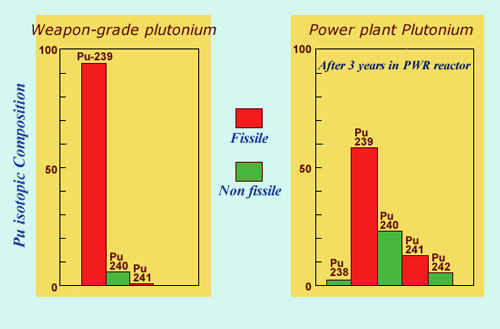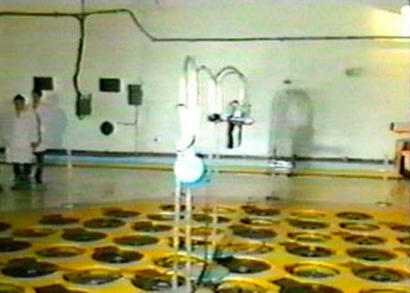Extracting weapon-grade plutonium from spent fuel

Civilian and military plutonium
The plutonium used in atomic bombs contains more of 239 isotope 239 than plutonium used in civilian reactors. Weapons-grade plutonium is enriched in idotoe 239 to 93% whereas the plutonium found in PWRs contains around 60%. The presence of 40% of other isotopes makes it inadequate for military uses – in particular, if the concentration of plutonium 240 is greater than 20% any bomb will be highly unstable.
© IN2P3
For the plutonium pathway, the key technology is the reprocessing of spent nuclear fuel. The goal is to extract from this spent fuel the fissile plutonium-239, the ingredient of atomics bombs. This plutonium-239 is formed in the fuel, when neutrons are captured by uranium-238 nuclei.
The weapon-grade plutonium used to manufacture bombs contains more than 93% of the fissile isotope plutonium 239. Concentration of plutonium 240 must not exceed 6%. Plutonium 240 has a significant rate of spontaneous fission and emits neutrons which trigger unwanted chain reactions. A concentration exceeding this threshold would cause pre-detonation of the bomb embarrassing for its reliability and bad for its effectiveness.
The plutonium found in the spent fuel of civilian reactors is made up of around 60% of the 239 isotope. The remaining 40% consists of heavier isotopes, around 25% of which is plutonium 240 – a high percentage that makes this plutonium inadequate for military uses.
Would it be possible to follow the uranium pathway by enriching this civilian plutonium so that it contains more than 93% of plutonium 239? Raising the concentration of plutonium from 60% to 93% seems easier than raising the concentration of uranium from 0.7% to 90%. So why not adapt and pass a gaseous plutonium compound through thousands of centrifuges? This is not possible. The safety problems would be insurmountable. Uranium hexafluoride can be used owing to its low radioactivity. A plutonium gas would be several million times more radioactive !

A North Korean reactor:
This old and rare television image of a North Korean nuclear reactor shows what appears to be an experimental reactor, with nuclear engineers moving around its top. Later in the film, these engineers can be seen removing fuel rods from the reactor.
© DR

Heavy water: Proliferating reactors
Iranwas building a small heavy water reactor at Arak, capable of producing 50MW of power. The IAEA withdrew their support from the project in 2006. Heavy water reactors are powered by natural uranium and do not require uranium enrichment. These are the method of choice for producing weapons-grade plutonium. There was suspicions that the purpose of this reactor, foreseen to operate in 2012, will be military. The project was stopped in 2015.
© DR/AP
The pathway to obtain weapon-grade plutonium is atomic piles. This was the method used during the Second World War at Hanford in the United States, before the Cold War motivated the development of “plutogenous” reactors designed to produce weapon-grade plutonium.
In such reactors, the fuel rods do not stay for more than 4 months, in order to limit the production of plutonium 240 through the capture of 2 consecutive neutrons. Reactors which use natural or low enriched uranium as fuel are moderated by heavy water or graphite. The fuel rods need to be taken out frequently. They can be processed to extract a plutonium rich in isotope 239. These reactors are prone to proliferation.
Even low power reactors can produce small quantities of plutonium: a 10MW reactor, for instance, can produce as much as 2kg of plutonium per year. This is the method currently employed by North Korea in its attempts to develop openly and produce a nuclear bomb.
The fourth generation reactors of the future will be designed to be resilient to proliferation. They should not be prone to the extraction of weapons-grade plutonium.
The threat of nuclear proliferation is currently a matter of great concern to the United States and elsewhere. For example they required through the AIEA that the Russians which provide the nuclear fuel of the Bushehr reactor in Iran, will take it back once spent. Such regulations may well be commonplace in tomorrow’s world, where nations will be forbidden access to fuel unless they offer satisfactory guarantees.
ALSO : The uranium pathway
Other articles on the subject « Nuclear Proliferation »
The uranium pathway
Centrifuging and enriching uranium 235 Taking the uranium pathway towards proliferation, the key [...]
Iranian Centrifuges
Technical Challenges: IR-1 and IR-2 Centrifuges Uranium enrichment requires significant technical[...]
North Korea
A country cut off from the world that blows hot and cold… The Democratic People’s Rep[...]